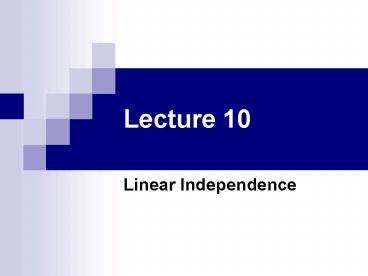Linear Independence - PowerPoint PPT Presentation
1 / 19
Title:
Linear Independence
Description:
Decide if a vector is a linear combination (belongs to the ... Decide if a set of vectors is linearly dependent (and if it is, find a dependence relationship) ... – PowerPoint PPT presentation
Number of Views:997
Avg rating:3.0/5.0
Title: Linear Independence
1
Lecture 10
- Linear Independence
2
Lecture 10 Objectives
- Decide if a vector is a linear combination
(belongs to the span) of a set of vectors - Describe the span of a set of vectors
- geometrically
- algebraically
- Decide if a set of vectors is linearly dependent
(and if it is, find a dependence relationship)
3
Example
- Let v1 1,2,3, v2 2,?1,1, v3 ?3,2,?4.
- Can the vector u ?4, 10, 3 be written as x
v1 y v2 z v3 , for some scalars x, y, z? - Note If we conveniently write the vectors as
column vectors, we can try solving
4
Solution
- The vector equation
is equivalent to the matrix equation
5
Solution
- Which is also equivalent to the system of
equations (considered in Lecture 8) - x 2y ? 3z ?4 2x ? y 2z
10 3x y ? 4z 3 - which has the unique solution x 3,
y ?2, z 1. - Since we found a solution, the answer is yes.
6
In general
- The system of linear equations
- a11x1 a12x2 ? a1nxn b1
- a21x1 a22x2 ? a2nxn b2
- ?
- am1x1 am2x2 ? amnxn bm
- which has the form Ax b, can also be expressed
as
7
Linear Combination
- Definition If the vector equation
- u c1v1 c2v2 ? cnvn
- holds, then we say that The vector u is
a linear combination of the vectors v1, v2, ?,
vn. - Note We only use addition and scalar
multiplication to get u from v1, v2,?, vn.
8
Example
- Is the vector u 1, 2, 3 a linear combination
of the vectors v1 4, 5, 6 and v2
7, 8, 9? - Interpret the answer geometrically.
9
Solution
- We can solve the equation u xv1 yv2 to get
x 2 and y ?1, or we can just check
that 1, 2, 3 24, 5, 6 ? 7, 8, 9. - Thus, u is indeed a linear combination of the
vectors v1 and v2. - Geometrically, this means that u lies in the
plane through the origin extended by the vectors
v1,v2.
10
Example
- Is the vector u 1, 2, 3, 4 a linear
combination of the vectors v1 0, 1, 1,
1, v2 1, 0, 1, 0, v3 0, 1, 0,
1. - Interpret the answer geometrically.
11
Solution
- We can check to see
- that the equation
- has no solution.
- Thus, u is NOT a linear combination of v1, v2,
and v3. - Geometrically, this means that u does not lie in
the hyperplane through the origin extended by the
vectors v1,v2, and v3.
12
Span
- Definition The set of all linear combinations of
the set of vectors S v1, v2, ?, vn is called
span(S), i.e. - span(S) c1v1 c2v2 ? cnvn c1,?,cn?R
- Notes span(S) is a set of vectors.
- It also represents the subset of the space that
can be reached from the origin by possible linear
combinations of the vectors.
13
Example
- Let v1 0, 0, 1, v2 1, 0, 1,
and v3 1, 1, 0. - Geometrically describe the following
- span(v1) , span(v1,v2) , and span(v1,v2,v3).
- Solution span(v1) The z-axis.
- span(v1,v2) The x-z plane
- span(v1,v2,v3) R3
14
Example
- Can the vectors v1 0, 0, 1, 1,
v2 1, 0, 1, 0, v3 0, 1, 0, 1,
span the whole 4 dimensional space R4, i.e.
is any vector u x, y, z, w ? R4 a linear
combination of the vectors v1,v2,v3?
15
Linear Dependence
- Definition The vectors v1, v2, ?, vn are called
linearly dependent iff at least one of them is a
linear combination of the others.
Otherwise, they are called linearly independent. - Example Show by inspection that the vectors e1
1, 0, 0, e2 0, 1, 0, e3
0, 0, 1, are linearly independent.
16
An Equivalent Definition
- Theorem The vectors v1, v2, ?, vn are linearly
dependent iff there is a nonzero solution for the
equation c1v1 c2v2 ? cnvn 0. - Note A nonzero solution means values for the
coefficients c1, c2, ?, cn that are not all
zeros. Observe that c1 c2 ? cn 0 gives the
so-called trivial (zero) solution.
17
Example
- Are the vectors v1 1, 3, ?2,
v2 1, 2, 0, v3 1, 0, 4, - linearly dependent?
- If yes, express one of them as a linear
combination of the others.
18
Solution
- Using the theorem we try solving the equation
c1v1 c2v2 c3v3 0, by getting the equivalent
augmented matrices
Since there is a nonzero solution, e.g. c1 2, c2
?3, c3 1, the vectors are dependent. Also, we
get the relation 2v1 ?3v2 v3 0, i.e. v3 3v2
? 2v1.
19
- Thank you for listening.
- Wafik































